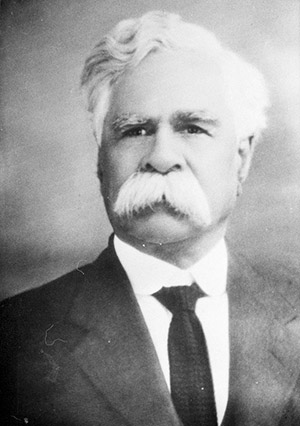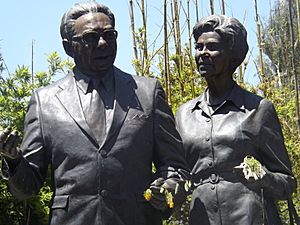William Cooper (Aboriginal Australian) facts for kids
Quick facts for kids
William Cooper
|
|
|---|---|
 |
|
| Inaugural Secretary of the Australian Aborigines League | |
| In office September 1933 – February 1941 |
|
| Succeeded by | Douglas Nicholls |
| Personal details | |
| Born | 18 December 1860 Moira, Victoria |
| Died | 29 March 1941 (aged 80) Mooroopna, Victoria |
| Nationality | Australian |
| Spouses | Annie Clarendon, Agnes Hamilton, Sarah MacRae |
| Profession | Shearer, Fishmonger, Community Leader, Political Activist |
William Cooper (born 1860 or 1861, died 1941) was an important Aboriginal leader in Australia. He was the first person to lead a national movement for Aboriginal rights that the Australian Government officially recognized. Cooper worked hard to make sure Aboriginal people had a voice and fair treatment.
Contents
William Cooper's Early Life
William Cooper was born on 18 December 1860 in Yorta Yorta country. This area is in Victoria, Australia, near where the Murray and Goulburn Rivers meet. His family was a small part of a much larger group. Cooper remembered seeing "500 men of my tribe, the Moiras, gathered on one occasion." Sadly, by his adult life, his family was almost the only part of his tribe left. Because of this, Cooper had to start working for farmers and landowners when he was very young.
Learning and Growing Up
On 4 August 1874, William Cooper, his mother Kitty, and his brother Bobby arrived at the Maloga Mission. This was an Aboriginal Mission on the Murray River, run by Daniel and Janet Matthews. Just three days later, Daniel Matthews noticed how quickly William learned to read. He wrote that Billy Cooper learned the alphabet in three days and then taught his brother Bobby.
Cooper's schooling at the mission was not regular. He could come and go as he pleased. He later said he only had about seven months of proper schooling. Instead of school, Cooper spent much of his childhood working for Sir John O'Shanassy. Sir John was a powerful politician and owned many large farms, including one on Cooper's mother's traditional land. Working for him, Cooper traveled a lot around Australia as a teenager. He even saw parts of the famous Burke and Wills expedition in the remote Lake Eyre Basin.
Returning to Maloga Mission
As a young man in his 20s, Cooper returned to Maloga Mission. These years seemed to be very happy for him. He wrote a letter later in his life, remembering the "glorious hours, days and months" they spent there. He spoke of the "beautiful singing, the picnics, the games."
It was during this time that Cooper became very interested in the Bible. In 1884, he decided to become a Christian. Being part of this faith community helped Cooper prepare for his life as an activist. Some people believe that stories from the Bible, like the Book of Exodus, inspired Cooper. These stories showed how people who were suffering could find freedom, just as the Yorta Yorta people hoped to do.
From 1881, Cooper also learned from Thomas Shadrach James. He was a teacher from Mauritius who taught at Maloga. Cooper read many books and learned about the fights for rights by Indigenous people in North America and New Zealand.
Fighting for Aboriginal Rights
William Cooper's long fight for Aboriginal rights, especially land rights, began in 1887. He was one of eleven people who signed the Maloga Petition. This petition was sent to the Governor of New South Wales. It asked for Aboriginal families to be given land. The petition said that Aboriginal people were the original owners of the land. Giving them land would help them earn their own living.
For most of his adult life, Cooper lived and worked on missions like Maloga. He also worked as a shearer, drover, and farm worker across many parts of Australia.
Moving to Melbourne and Starting a Movement
When Cooper was in his 70s, he moved to Footscray in Melbourne in 1933. He found out he couldn't get a pension if he stayed on an Aboriginal reserve. In Melbourne, he became a strong activist and organizer. He wrote many letters to leaders.
By 1935, Cooper helped start the Australian Aborigines' League. As the secretary, he created a petition asking for Aboriginal people to have a voice in parliament. He also asked for voting rights and land rights. He wanted to send this petition to King George V. Over several years, he and his team collected 1814 signatures. This was difficult because the Australian and state governments tried to stop them.
The petition was received by the government in August 1937. But by February 1938, the government decided not to send it to the King.
Meeting with Leaders
Cooper was also good at getting meetings with government leaders. In 1935, he was part of the first group of Aboriginal people to meet with a Commonwealth minister. In 1938, he was part of the first group to meet with the Prime Minister. The government ignored his requests. By the late 1930s, the government even watched his activities closely.
The Day of Mourning
When democratic ways didn't work, Cooper's Australian Aborigines League joined with other groups. They planned a Day of Mourning on Australia Day, 1938. This event marked 150 years since British settlement. It was held in Sydney and was the first protest by Aboriginal Australians from different states. Cooper said, "Now is our chance to have things altered. We must fight our very hardest in this cause."
Cooper retired in November 1940 and moved to Barmah, Victoria. He was made an honorary life member and president of the Australian Aborigines League. He continued to protest unfair treatment until he passed away on 29 March 1941.
William Cooper's Family
William Cooper's mother, Kitty Cooper, was a Wollithica woman who spoke Yorta Yorta. His father was James Cooper, a white laborer. William grew up around Moira Station.
Cooper married Annie Clarendon Murri in 1884. She passed away in 1889, as did their first child, Bartlett. Their daughter Emma survived. Four years later, Cooper married Agnes Hamilton. They had six children: Daniel, Amy, Gillison, Jessie, Sarah, and Lynch. Agnes died in 1910.
Their son Daniel, named after Daniel Matthews, fought in World War I. He was killed in Belgium in 1917. This loss deeply saddened Cooper. When another war was coming, Cooper argued that his people should not fight until they had "something to fight for" in their own country.
His daughter, Amy Charles, became the head of the first Aboriginal hostel in Melbourne in 1959. His son, Lynch Cooper, was a famous athlete. He won the 1928 Stawell Gift and the world professional sprint championship in 1929.
At age 65, William married Sarah Nelson. She supported him during his most active years as a community leader. They did not have children together, but she helped raise his many grandchildren.
Cooper had many important relatives, including his nephew and mentee, Pastor Sir Douglas Nicholls. Douglas Nicholls later became the Governor of South Australia.
Protest Against Kristallnacht
On 6 December 1938, William Cooper led a group from the Australian Aborigines' League to the German Consulate in Melbourne. This was several weeks after Kristallnacht in Germany. Kristallnacht was a terrible night when Jewish people were attacked and their homes and businesses destroyed by the Nazi government. Cooper's group delivered a petition that spoke out against the "cruel persecution of the Jewish people by the Nazi government of Germany."
Some historians believe that Cooper chose to protest at the German Consulate to show how similar the treatment of Jewish people in Germany was to the treatment of Aboriginal people in Australia. The German Consulate did not accept the petition at the time. However, 79 years later, Cooper's grandson, Alf Turner, presented a copy of the letter to the consulate.
In 2018, members of the Jewish community in Victoria organized a walk to remember William Cooper. They walked the same path he took to the German Consulate in 1938.
William Cooper's Legacy
During his lifetime, William Cooper didn't achieve many of his main goals. One success was the creation of Aborigines Sunday, which began in churches across Australia in 1940. This day is still celebrated today as NAIDOC Week. However, many of his ideas and efforts have been recognized long after his death.
His influence inspired the next generation of Aboriginal activists, especially his nephew Douglas Nicholls. Nicholls helped create the Federal Council for the Advancement of Aborigines and Torres Strait Islanders. This group successfully pushed for changes to the Australian Constitution. This led to the 1967 Australian referendum, where most Australians voted to include Aboriginal people in census counts and allow the federal government to make laws for Indigenous Australians.
The Cummeragunja Reserve, which is still an Aboriginal community today, also exists because of Cooper's early work. The Maloga Petition, which Cooper signed, led the government to set aside land for Aboriginal use. This land became known as Cummeragunja.
Recognized in the 21st Century
In recent years, the Jewish community has shown great appreciation for Cooper's actions. In 2002, a plaque was put up at the Jewish Holocaust Centre in Melbourne. It honored the Aboriginal people for protesting against the persecution of Jews in 1938. The story of Cooper's protest is now a permanent part of the museum.
On 6 December 2008, Cooper's grandson, Alfred "Boydie" Turner, received a special certificate. It said that 70 trees would be planted in Israel to honor William Cooper. This ceremony was held in Melbourne and attended by many Yorta Yorta people, politicians, and Jewish leaders. In April 2009, five trees were planted at the Forest of the Martyrs near Jerusalem.
On 5 October 2010, a court building in Melbourne was named the William Cooper Justice Centre. In December 2010, there were three more events to honor Cooper:
- Cooper's great-grandson, Kevin Russell, re-enacted the walk from Cooper's home.
- Cooper was honored in Israel with a special academic position to support research on the Holocaust.
- A tribute was held at the Yad Vashem World Holocaust Memorial.
In 2012, Cooper's grandson, Uncle Alf (Boydie) Turner, led another re-enactment of the march. This time, the German consul-general in Melbourne finally accepted a copy of Cooper's protest letter.
The William Cooper Cup is an annual award in Australian rules football. It is given to the winner of a match between the Aboriginal All-Stars and Victoria Police.
In June 2018, the Australian Electoral Commission renamed a federal voting area from the Division of Batman to the Division of Cooper in his honor. In December 2019, plans were announced for a Holocaust museum in Perth that would include a memorial to William Cooper.


